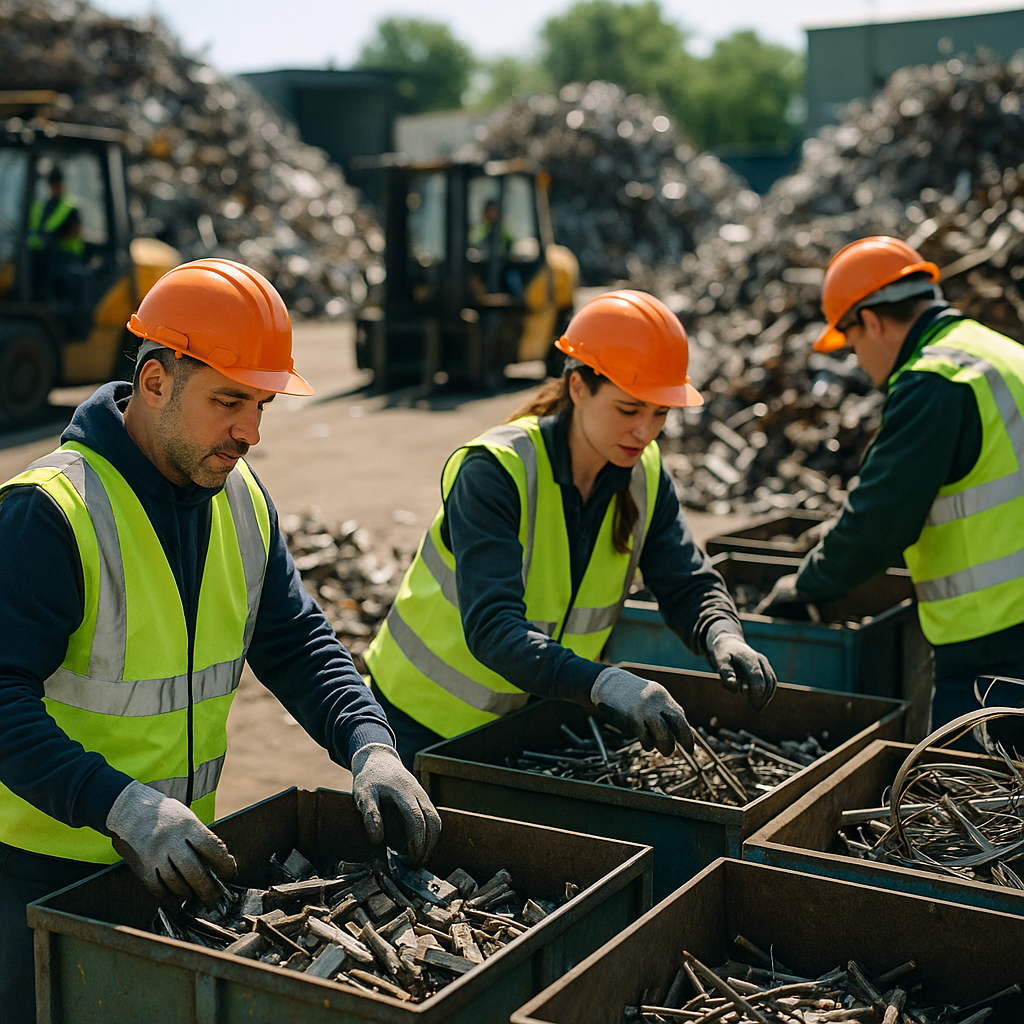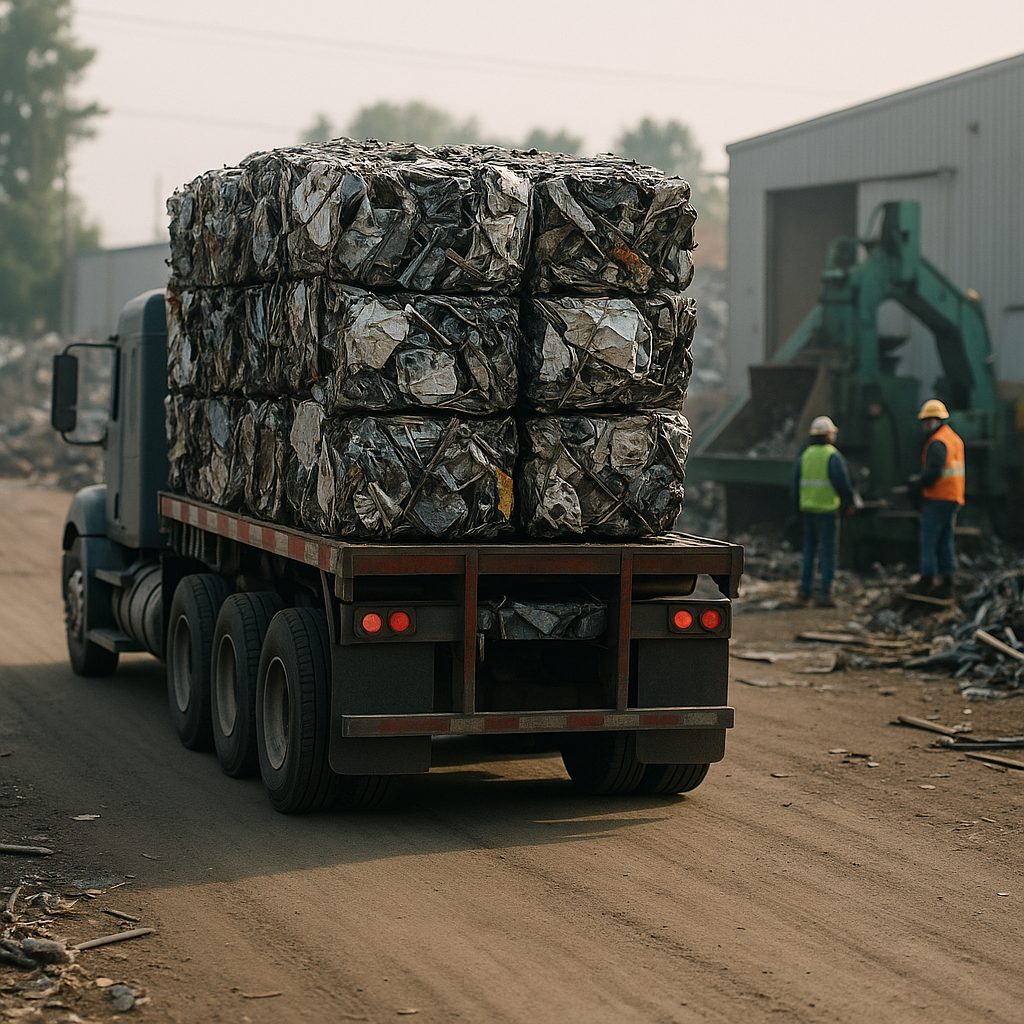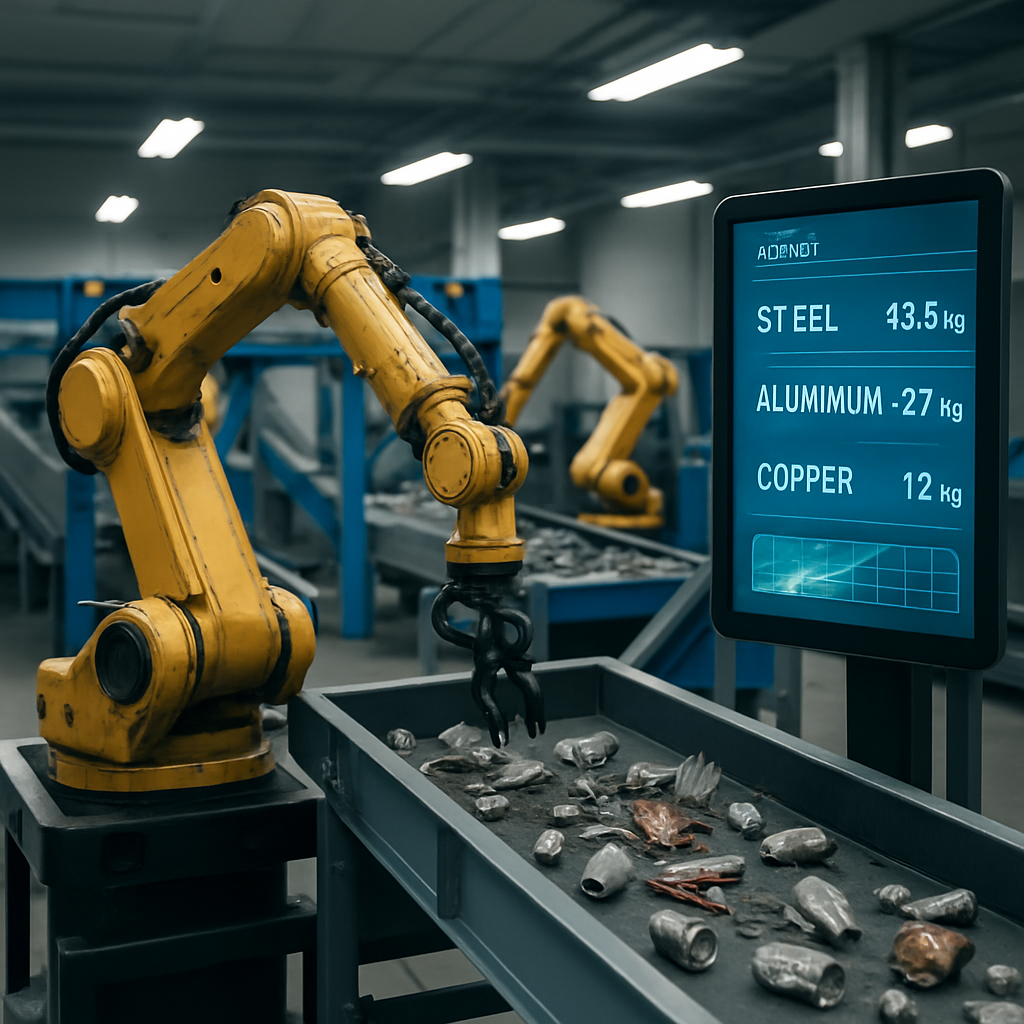5901 Botham Jean Blvd, Dallas, TX 75215
The Scrap Metal Procurement Process Explained: Sourcing, Pricing & Logistics
October 17, 2025The scrap metal procurement process is a systematic method for sourcing, collecting, and purchasing metal materials that have reached the end of their useful life. This essential first step in metal recycling involves identifying reliable sources of scrap, assessing material quality, negotiating fair prices, and coordinating efficient transportation to recycling facilities.
At its core, scrap procurement transforms materials often considered waste into valuable resources for manufacturing. The process starts with sourcing from various generators, including manufacturing facilities, construction sites, demolition projects, and end-of-life products. Procurement specialists then evaluate the materials for composition, condition, and recyclability before setting prices based on current market conditions.
This process is fundamental to the circular economy of metal. By efficiently collecting and processing scrap, we reduce the need for environmentally harmful mining operations while conserving significant energy. For instance, recycling aluminum saves up to 95% of the energy required to produce new aluminum from raw materials, while steel recycling conserves about 75% of the energy needed for primary production.
How Does Scrap Metal Collection and Sorting Work?

Scrap metal collection is the first crucial step in the recycling process. Collection teams gather metal materials from various sources in industrial and consumer sectors. These materials then undergo sophisticated sorting processes to separate metals by type and quality, preparing them for recycling.
Collection Sources
The scrap metal industry gathers materials from a wide range of sources, each contributing different types and qualities of metal to the recycling stream.
- Industrial manufacturing waste (offcuts, shavings, and production byproducts)
- Construction and demolition debris
- End-of-life vehicles and automotive parts
- Obsolete machinery and equipment
- Electronic devices and components
- Household appliances and consumer goods
- Utility infrastructure replacement (pipes, wires, poles)
Collection methods vary based on volume and location. Large industrial facilities often use designated containers placed strategically throughout their operations. For demolition projects, specialized equipment handles heavy materials and separates them on-site.
The Sorting Process
Once collected, scrap metal undergoes a multi-stage sorting process. This critical phase determines the quality and value of the recovered materials. Modern recycling facilities combine traditional methods with advanced technologies for precise separation.
Initial sorting begins with separating ferrous (iron-containing) from non-ferrous metals. Magnetic separators pull ferrous materials like steel from the stream, while non-ferrous metals such as aluminum, copper, and brass continue to secondary sorting stages.
Workers remove obvious contaminants and large non-metallic attachments during a manual pre-sorting phase. This step improves the efficiency of automated systems by removing items that might damage equipment or contaminate batches.
Advanced Sorting Technologies
Today’s scrap metal facilities rely on sophisticated technologies to enhance sorting accuracy and speed. These systems can identify and separate materials that would be impossible to differentiate manually.
Electromagnetic separators use powerful magnets to extract ferrous metals from mixed streams. These systems range from simple overhead magnets to complex drum separators processing tons of material hourly.
Eddy current separators create magnetic fields that repel non-ferrous metals while allowing non-metals to fall naturally. This technology effectively separates aluminum, copper, and other valuable non-ferrous metals from waste streams.
Optical scanning systems use cameras and sensors to identify metals based on color, shape, and texture. Advanced versions incorporate artificial intelligence that continuously improves sorting accuracy through machine learning.
X-ray fluorescence (XRF) technology analyzes the chemical composition of metals to determine alloy types. This allows for precise identification of high-value specialty metals and ensures proper classification of materials that look similar but have different compositions.
Contaminant Removal
The final sorting phase focuses on removing contaminants that would reduce material quality. Oil, paint, plastic attachments, and other non-metallic materials must be eliminated before the metal moves to processing.
Shredders break down larger pieces into smaller fragments, exposing embedded materials and making separation more efficient. Air classification systems then use controlled airflow to separate lighter contaminants from heavier metals.
Water-based separation techniques rely on density differences to separate materials. Heavier metals sink while lighter contaminants float, allowing for efficient separation without chemical processes.
These combined technologies ensure that sorted metals meet quality standards for recycling facilities. The cleaner and more accurately sorted the material, the higher its value and the more efficiently it can be processed into new products.
| Sorting Technology | Function | Applications | Advantages |
|---|---|---|---|
| Magnetic Separators | Removes ferrous metals | Steel and iron separation | Efficient for bulk separation |
| Eddy Current Separators | Repels non-ferrous metals | Aluminum and copper sorting | Non-ferrous metals recovery |
| Optical Scanners | Identify metals based on visual characteristics | Color and shape differentiation | High sorting precision |
| X-ray Fluorescence (XRF) | Analyzes chemical composition | Alloy identification | Ensures material purity |
| LIBS (Laser-Induced Breakdown Spectroscopy) | Analyzes metals at a microscopic level | Metals and alloys analysis | Non-destructive, rapid results |
Once sorting is complete, processors compact the separated metals into dense bales or bundles for efficient transportation to smelters and mills. Here, the materials begin their transformation back into new products, completing the recycling loop.
What Are the Key Considerations in Scrap Metal Pricing and Negotiation?

Scrap metal pricing is based on a complex set of variables that buyers and sellers must understand to secure the best deals. Knowing these factors is crucial for maximizing value in the recycling market.
Market-Driven Pricing Factors
The most fundamental influence on scrap metal pricing is the principle of supply and demand. When construction activity increases during warmer months, steel scrap prices typically rise due to elevated demand. Conversely, these materials often decrease in value during winter slowdowns.
Global economic conditions also significantly affect price determination. When manufacturing leaders like China or India boost industrial production, their increased need for materials can drive up scrap metal prices worldwide. Economic downturns, on the other hand, reduce demand and lower prices across markets.
Metal type and quality can also lead to substantial price differences. Copper, used extensively in wiring and plumbing, generally commands higher prices than more common metals like steel. Clean, well-sorted materials free from contaminants such as paint or rubber earn premium rates compared to mixed or contaminated scrap.
Pricing Models and Structures
Buyers should be familiar with several pricing approaches when negotiating scrap metal purchases:
Spot pricing reflects immediate market rates for single transactions. This model offers flexibility but exposes both parties to market volatility. Contract pricing establishes fixed or formula-based rates over defined periods, providing stability and predictability. Tiered pricing structures offer rate incentives based on volume, rewarding larger quantities with better prices.
Many industry professionals recommend tying scrap metal prices to recognized commodity indices. This ensures rates move in line with broader market trends, protecting both buyers and sellers from isolated price manipulations. For instance, a steel processing facility might negotiate a price differential of $50 below the American Metal Market index for HMS 1 scrap.
Strategic Negotiation Approaches
Effective negotiation requires thorough preparation and strategic thinking. Start by reverse-engineering price differentials to understand the true costs involved. Processing expenses, transportation, labor, and preparation for mills all influence the final price margin suppliers need to maintain.
Supplier selection criteria should extend beyond basic price considerations. Evaluate potential partners based on reliability, transparency, material handling capabilities, and industry reputation. A supplier offering slightly higher prices but inconsistent quality or delivery may ultimately cost more than a reliable partner with competitive rates.
The concept of total cost of ownership is valuable in scrap metal procurement. This accounts for all costs associated with a supplier relationship, including transportation, material preparation, quality assurance, and administrative overhead. A seemingly higher price may represent better value when these factors are considered.
| Factor | Description |
|---|---|
| Global Demand and Supply | The balance between demand from industries like construction, automotive, and technology and the available supply affects prices. High demand generally leads to higher prices. |
| Energy Costs | The recycling process is energy-intensive, and changes in energy costs directly impact processing expenses and ultimately affect scrap metal prices. |
| Currency Exchange Rates | Exchange rates impact the competitiveness of exports and imports, influencing local and global scrap metal prices. |
| Regulations and Policies | Stricter environmental regulations can increase demand for recycled metals, affecting their prices. |
| Technological Advancements | Innovations in recycling processes can make the recycling of scrap metals more efficient and cost-effective, thereby influencing prices. |
| Seasonal Variations | Demand can fluctuate with the seasons, particularly with industries like construction affecting scrap metal prices accordingly. |
| Quality of Scrap Metal | The condition and quality of scrap metal, including contaminants, can influence its value and pricing. |
Practical Negotiation Tactics
Build strong relationships with reputable scrap metal buyers. Regular communication and consistent business dealings often lead to preferential treatment, better pricing, and more flexible terms. Some recyclers offer volume discounts or improved rates to steady suppliers.
Maintain precise transaction records. Periodically request weight verification from independent scales to ensure accuracy. Public weigh stations provide impartial validation that protects both parties from discrepancies.
Address quality downgrades proactively by establishing clear specifications upfront. When materials are downgraded, request documentation explaining the decision. This transparency prevents arbitrary price reductions and builds accountability.
Consider timing your sales strategically based on seasonal trends and market conditions. Prices typically rise during the construction season and fall during winter months. Monitoring industry publications and market indices helps identify favorable selling opportunities.
Clean and properly sort your scrap metal before negotiation. Well-prepared materials demonstrate professionalism and justify premium pricing. The time invested in preparation often yields significant returns through improved rates.
How is Scrap Metal Transported and Processed?

The journey of scrap metal from collection points to its eventual transformation into new products involves sophisticated logistics and processing techniques. This critical phase in metal recycling requires careful planning and specialized equipment to ensure efficiency and quality.
Strategic Transportation Networks
Transporting tons of scrap metal across regions and countries demands a robust infrastructure. Recycling companies utilize multiple modes to optimize efficiency and minimize costs.
Railways serve as the backbone for long-distance scrap metal transport. A single freight train can carry the equivalent of dozens of trucks, making rail ideal for moving bulk quantities over long distances. This approach reduces road congestion and lowers the carbon footprint of recycling operations.
Highways connect collection points to processing facilities via truck transport. Specialized vehicles with reinforced beds and high sides ensure safe transportation by preventing materials from shifting or falling during transit.
Waterways offer an economical solution for facilities near ports or navigable rivers. Barges can transport massive volumes of scrap metal with relatively low fuel consumption, which is particularly beneficial for international trade.
Processing: Breaking Down and Building Up
Once scrap metal arrives at processing facilities, it undergoes a series of transformative steps to convert mixed metal waste into pure, usable materials.
Initial sorting and separation involve magnetic separators to pull ferrous metals from the mix, while eddy current separators identify and remove non-ferrous metals. Advanced techniques like X-ray fluorescence and optical sorting achieve precise material separation.
Shredding reduces large metal pieces into manageable fragments. Industrial shredders with high-torque motors and hardened steel blades process everything from household appliances to automotive components. This size reduction increases surface area, improving melting efficiency in subsequent steps.
Compacting and baling prepare metals for efficient transportation to smelting facilities. Hydraulic balers compress loose scrap into dense blocks, maximizing shipping space and facilitating handling.
Metallurgical Transformation
At the core of scrap metal processing is metallurgical transformation through melting and refining. This stage converts processed scrap into new metal products with specific properties.
Electric arc furnaces represent the primary technology for recycling ferrous scrap, using graphite electrodes to create an electric arc that generates temperatures exceeding 3,000°F. This intense heat melts even robust steel alloys while consuming significantly less energy than traditional blast furnaces.
Ladle refining serves as an essential intermediate step where molten metal undergoes chemical adjustments. Metallurgists add specific elements to achieve desired properties or remove impurities through reactions with specialized slag compounds. The ladle’s controlled environment allows precise manipulation of the metal’s composition.
Vacuum degassing removes dissolved gases from molten metal to improve quality. Subjecting molten metal to a vacuum allows hydrogen and other gases to escape, reducing porosity risk and enhancing mechanical properties in the final product.
Continuous casting transforms molten metal into solid forms ready for fabrication. Instead of pouring metal into static molds, continuous casting machines produce uninterrupted streams of metal slabs, billets, or sheets that can be directly fed into rolling mills or other forming equipment.
Quality Control Throughout the Process
Quality control measures ensure recycled metal meets industry standards throughout transportation and processing. Facilities use spectrometers to verify chemical composition and various mechanical tests to confirm physical properties.
Modern processing facilities integrate automation and data management systems to track material movement, processing parameters, and quality metrics. This oversight helps optimize operations while providing traceability for regulatory compliance.
The complexity of metal recycling logistics and processing highlights why specialized facilities are essential to the circular economy. These operations transform potential waste into valuable resources, reducing the need for virgin material extraction.
The efficient movement and transformation of scrap metal are crucial links in sustainable material management. As technology advances, these processes continue to improve efficiency, reducing energy consumption and environmental impact while producing high-quality recycled metals for global industries.
Conclusion: The Future of Scrap Metal Procurement

Scrap metal procurement is a cornerstone of sustainable metal production and the circular economy. The industry is evolving with technological innovations like AI-powered sorting systems, robotics, and blockchain technology transforming material collection, processing, and tracking. These advancements enhance operational efficiency and ensure higher quality recycled materials for manufacturing sectors worldwide.
The environmental benefits of efficient scrap metal procurement are notable. Recycling aluminum uses up to 95% less energy than new production, while steel recycling conserves about 75% of energy needed for primary production. These practices significantly reduce greenhouse gas emissions, minimize resource extraction, and decrease landfill waste. As environmental regulations tighten globally, businesses embracing sustainable procurement practices position themselves for long-term success in an eco-conscious marketplace.
For your scrap metal recycling needs and to learn how your business can benefit from sustainable procurement practices, contact Okon Recycling at 214-717-4083.
